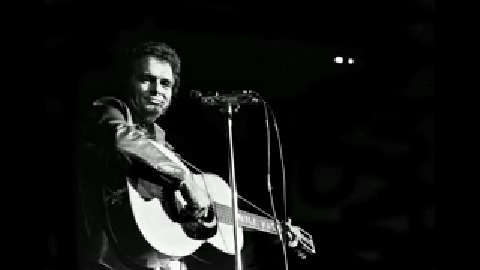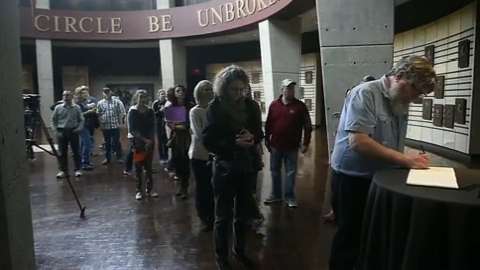Merle Haggard dead at 79

Merle Haggard, the working man’s poet, an architect of the Bakersfield Sound and a fiercely independent artist who influenced country music like few others, died Wednesday in California, surrounded by friends and family.
He had just turned 79 and had been in failing health for some time, leading to the diagnosis of double pneumonia and subsequent cancellation of several concert dates, including two nights at the Ryman Auditorium that were originally scheduled for March.
Over the length of his half-century career, Mr. Haggard recorded 38 No. 1 country singles and wrote some of the genre’s most revered classics, which have been recorded by Dolly Parton, Emmylou Harris, The Byrds, Vince Gill, The Grateful Dead and countless others.
"Merle Haggard's reach knew no bounds," said Jay Orr, a historian at the Country Music Hall of Fame and Museum. Orr also noted that Mr. Haggard so embodied country music that the museum's core exhibit, "Sing Me Back Home," takes its title from a chart-topping song he released in 1968.
Mr. Haggard’s life, which took him from a San Quentin prison cell to the Country Music Hall of Fame, was a truly American success story.
“In some ways, his life sounds like fiction, but if it were fiction, no one would believe it,” said Harris on the night of his Hall of Fame induction.
Born to Oklahoma migrants James and Flossie Haggard on April 6, 1937 in Bakersfield, Calif., Merle Ronald Haggard was the youngest of three children. The Haggard family lived in a converted railroad car in Oildale, Cal.
After his father died of a stroke in 1946, Merle started getting into trouble. At the age of 10, he hopped his first train with a friend and made it to Fresno, Calif., before he got caught. The rebellious young man spent time in juvenile facilities and reform schools over the next several years, but he also fell in love with music and began learning to play guitar. He was captivated by country artists such as Lefty Frizzell, Western Swing pioneer Bob Wills and “America’s Most Colorful Hillbilly Band”: The Maddox Brothers and Rose.
When Mr. Haggard was 20, he was sent to San Quentin State Prison after a burglary attempt, a crime for which he'd receive a "full and unconditional pardon" in 1972 from California's then-Gov. Ronald Reagan. While imprisoned, he saw country star Johnny Cash perform for the inmates, played in the prison band and worked in the San Quentin textile mill. Upon his 1960 release, Mr. Haggard — who was by then married to his first wife, Leona Hobbs, with whom he’d have four children — was determined to turn his life around.
Mr. Haggard’s days were filled with labor — ditch digging and electrical work — but his nights belonged to music. He got involved in the Bakersfield country music scene alongside up-and-coming artists such as Buck Owens and Wynn Stewart. Two thousand miles away in Music City, the Nashville Sound was full of lush string arrangements, but the sounds coming out of Bakersfield were harder, twangier and absolutely irresistible. After a short stint playing bass for Owens, Mr. Haggard joined Stewart’s band.
In 1962 he released his debut single, “Skid Row.” His second single, “Sing Me a Sad Song,” was written by Stewart. It became Mr. Haggard’s first Top 20 hit for Tally Records, a small label co-founded by Fuzzy Owen, who’d spend several decades as Mr. Haggard’s manager.
While working the bar and club circuit, Mr. Haggard recorded “Just Between the Two of Us,” a duet with future wife Bonnie Owens, and “(My Friends Are Gonna Be) Strangers,” which captured the attention of Capitol Records’ Ken Nelson, who signed him and Owens to the label.
When they met, Bonnie Owens was the bigger name, but Mr. Haggard’s fame soon eclipsed hers. They married in 1965 and she spent years helping to raise his children and singing backup for him as part of his top-notch backing band The Strangers. After they divorced, Owens continued to work with Mr. Haggard, and even served as a bridesmaid when he married Leona Williams in 1978.
From the mid-1960s through the ‘70s, Mr. Haggard released one top-notch song after another, a string of hits that are now an integral and beloved part of the country music canon, including "Sing Me Back Home," "Hungry Eyes," "Workin' Man Blues" and "Mama Tried." Many singles topped the charts, beginning in 1965 with his first No. 1 single, “I’m a Lonesome Fugitive.”
Other songs that weren’t released as singles, including “Today I Started Loving You Again” (perhaps the Haggard song most covered by other artists) and “Irma Jackson,” about an interracial romance, display Mr. Haggard’s depth as an artist.
“I’m the first to admit the English language is not my specialty,” Mr. Haggard wrote in the preface to his 1999 autobiography, “My House of Memories.” However, the plainspoken power of his lyrics touched listeners across generations.
In 1969 Mr. Haggard released a career-changing song, “Okie From Muskogee,” about the values of small-town life. Co-written with Roy Edward Burris, it spent four weeks atop the country charts and crossed over to the pop charts as well. “Okie” was followed by another hard-nosed single, 1970’s “The Fightin’ Side of Me.” Both became signature songs for Mr. Haggard, and after the songs were released, he rarely, if ever, left a stage without playing them.
"'Okie' made him a star," said music historian and journalist David Cantwell," author of "Merle Haggard: The Running Kind."

"It brought him TV appearances and magazine profiles, and with a pop-roots sound and class-savvy songs that were well-respected among rock and country musicians alike, he had a chance there to become a pop star like Johnny Cash or Glen Campbell. His initial thought for a follow-up, 'Irma Jackson" ... could have been a big pop hit. But the record he released instead, 'Fightin' Side,' took sides and shrunk him back down to country-star size. And that's where he stayed even as his melodic elegance and blue collar smarts continued to grow."
“Twinkle, Twinkle Lucky Star” in 1987 was Mr. Haggard’s last single to top the charts.
Throughout his career, Mr. Haggard wore his influences on his sleeve. He released tribute albums honoring two of his favorite artists, Jimmie Rodgers and Bob Wills, and his 1983 version of “That’s the Way Love Goes,” which was co-written by another artist he admired, Frizzell, spent 21 weeks on the charts and earned him a Grammy for Best Male Country Vocal Performance. Just as Mr. Haggard studied the works of his musical heroes, contemporary acts look to him: stars such as George Strait and Miranda Lambert have cited him as influences, and Eric Church recorded a song called “Pledge Allegiance to the Hag.”
Mr. Haggard was inducted into the Country Music Hall of Fame in 1994. During his induction speech, he unfurled a five-foot-long list of people he wanted to thank, beginning with, he deadpanned, his plumber. That year, Haggard’s single “In My Next Life” peaked at No. 58 on the charts. Though country radio didn’t seem to have much use for Mr. Haggard during the Hot New Country era of the 1990s, by the end of the decade, he was poised for a comeback. He began cranking out albums, including two for punk label Anti- in 2000 and 2001; a bluegrass record, “Kickin’ Out the Footlights ... Again” with George Jones; and “Last of the Breed,” a double-disc album with Willie Nelson and Ray Price.
Mr. Haggard did experience a small setback in 2008 when he was diagnosed with lung cancer. After recovering from surgery in which a piece of his lung was removed, he resumed rambling, playing 100-plus shows per year.
Performing was where he felt most at home: In 1986 Mr. Haggard told Patrick Carr of “Country Music Magazine,” “Probably the happiest moments of my life have been on a stage. …The stage is a refuge for me, and it always has been. Over the years, I’ve climbed inside my music when things went wrong. I still do that. My music is where I really live.”
In 2010 Mr. Haggard traveled to Washington to receive the prestigious Kennedy Center Honors, which are given to those in the performing arts for their contributions to American culture.
His last solo album, “Working in Tennessee,” was released in 2011, and in 2015 he released two more collaborative albums: one with legendary country/bluegrass singer Mac Wiseman and “Django and Jimmie” with Willie Nelson. The latter featured the two legends warmly meditating on their mortality with songs such as “Live This Long” and “Missing Ol’ Johnny Cash,” but they still made room for humor with the record’s lead single, “It’s All Going to Pot.”
"He was such a gentleman, and he left a heck of a legacy," said Wiseman after Mr. Haggard died. The two men first met in California during the late 1950s; they became dear friends and mutual admirers of each other's work. Their recent album together, "Timeless," was, Wiseman said, "a labor of love" for the both of them.
Mr. Haggard is survived by his wife, Theresa, whom he married in 1993, and his children, Dana, Marty, Kelli, Noel, Ben and Jenessa.
Funeral arrangements are not available at this time.


